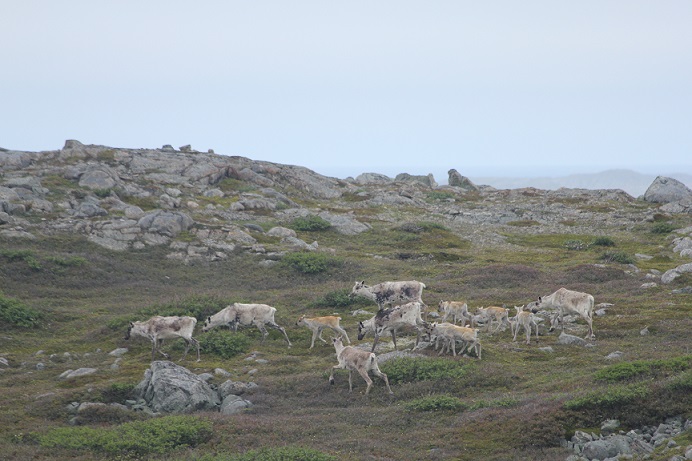Short-term patience
We slog across the barrens as the rain comes at us sideways. We’re dressed appropriately for the weather – I’m still dry. Visibility is not great, but we see a caribou in the distance. I pull out my binoculars and my lab-mate asks: “do you see a calf?”. I squint through the rain and fog and can’t quite tell. We’ll have to get closer. We scale a rocky hill to get a better view – the rain picks up and we’re all drenched now. I may as well have jumped in the ocean wearing all my clothes, I think. After a second look it turns out this is a lone caribou; no calf. We continue.
The rain also continues. What feels like hours later, the rain has let up a little bit and we’re navigating a thicket of alder and as I curse the alder under my breath I notice another caribou across a nearby lake. We stop and look. It’s not clear if she’s alone, or not. After watching through binoculars for a few minutes we notice a small reddish shape in the bushes. “A calf! She has a calf!” I say excitedly. This is what we’re here for and this is why we slog through the sideways rain – it’s worth it!
Our lab has initiated the Fogo Island Caribou Ecology Project where we study behaviour, ecology, and evolution of the Fogo Island caribou herd and we’re now in the second year of the project. This year, seven of us travelled to Fogo Island to study caribou during a critical time-period: calving. For about two weeks in late May and early June, female caribou give birth to their calves. One of the most important ways to know if an animal population is healthy is to know how many calve are born each year, and how many of them reach adulthood. Although this data likely won’t make it into my thesis, or those of my peers, we are collecting it as baseline data that will contribute to the future of the project as well as future theses.
Long-term patience
Although we’re only in the second year of the project, the ultimate goal is to establish a long-term study population. What’s a long-term study population? Around the world, researchers have been studying animal populations in the same spot for very long-periods of time. In some cases, like Fogo, these populations are on islands. For example, Soay Sheep on St. Kilda (a small island in Scotland) or red deer on the Isle of Rhum (England). In many of these study systems researchers study a wide-range of topics – many of which are made possible by the long-term nature of the data collection. For instance, to study whether a certain behaviour is heritable (i.e. has a genetic basis and is therefore passed from parent to offspring), we would need to wait and monitor at least two generations (but preferable many more). In the case of long-lived animals, like caribou, it can be several years before females reproduce, so asking certain ecological and evolutionary questions can take many years before these data are usable in this context.
This means we’re investing in the long-run. Of course, I am collecting data that I will use in my own thesis, but the type of data collection I’m doing is tailored so it can be usable in the short-term for my thesis, but also, usable long-term as well – potentially to help future students.
In the moment, it can be challenging to juxtapose the present (rain storms) and future (long waiting periods), but I try to remind myself that patience is a virtue.
~Quinn https://www.zp-pdl.com https://zp-pdl.com/online-payday-loans-in-america.php
